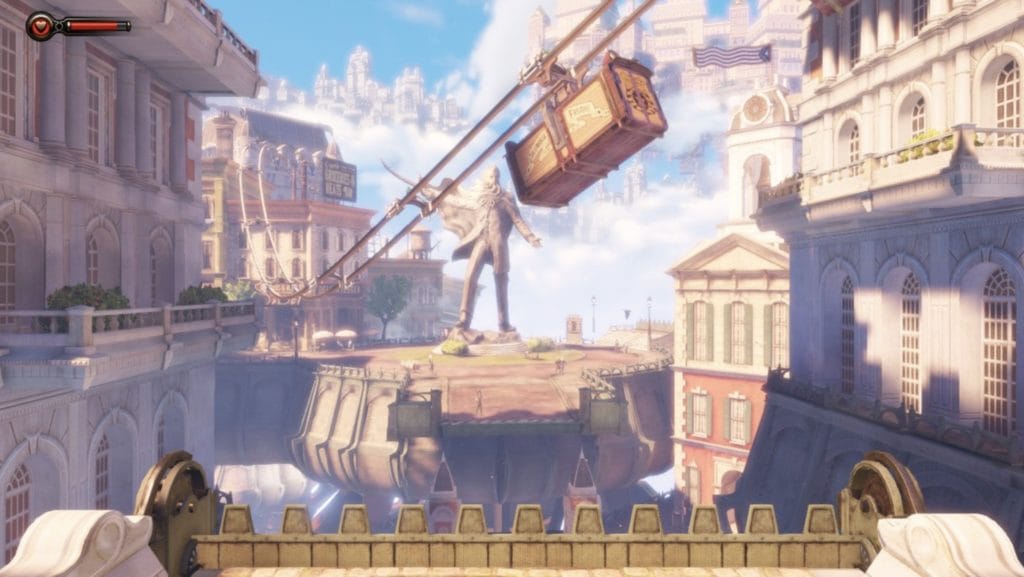One of the biggest draws for Nintendo’s Switch is the small console’s ability to allow AAA gaming while on the move. In the few short years since release, the Switch has skyrocketed in popularity. For many people, it has become the quintessential gaming device. A portable that can be docked for traditional television gameplay, or removed and taken practically anywhere. The freedom of being able to play almost any kind of game, whether at home, work or whilst travelling, is an incredible draw that speaks directly to the console’s popularity. The success of the console has incited popular studios to bring their titles to the console, with one of the most recent being BioShock: The Collection from 2K Games.
Originally released in 2016 for PC (Windows and Mac), Xbox One and PlayStation 4; BioShock: The Collection includes all three games in the franchise as well as their add-on content. To clarify, the package includes BioShock, BioShock 2, BioShock 2’s Minverva’s Den, BioShock Infinite, and BioShock Infinite’s Burial at Sea. It should also be noted how the first and second games in the collection were also completely remastered with upgraded audio and visuals. In addition, Bioshock: The Collection also includes a directors commentary by the series creative director, Kevin Levine; the challenge modes for all three games; and the Museum of Orphaned Concepts, which is a gallery of abandoned game development concepts. Strangely, the collection does exclude BioShock 2’s multiplayer component (for all platforms).

For those familiar with the BioShock series and who are only interested in finding out how it performs on Nintendo’s Switch, feel free to skip the next few paragraphs. For readers who are completely new to the series (a remarkable feat, as I wish I could experience them all over again for the first time) the following is a very brief and spoiler free overview of the narrative’s featured in BioShock: The Collection; which are some of the most engrossing narratives available in video games.
In Bioshock, you take on the role of Jack. Your plane crashes over the ocean near a light house, which just so happens to be an entrance to the underwater city of Rapture. It is here where you are exposed to a 1960s utopia built by a man named Andrew Ryan. It is a city filled with wondrous awe, and is meant to serve as a means of escaping the tyrannical and authoritarian government regimes that now control and plague the world. Of course, everything is not as it seems. As glorious as Rapture appears at first, the discovery of a superpower endowing substance called ADAM causes the burgeoning utopia to begin to fall from grace. A subsequent war ensues over who might control this marvellous new substance, which results in the creation of the infamous Big Daddies and Little sisters. The twists and turns in the narrative are some of the most memorable and shocking in any video game, and make the original BioShock a must play title for all gamers.
BioShock 2 returns players to rapture, but in a completely different role to the first title. Eight years have passed since the end of Jack’s story. Unlike the utopia presented in the first title, Rapture in BioShock 2 has fallen into a dystopia. A new leader by the name of Sophia Lamb has taken control, turning the once free and wondrous underwater city into a utilitarian and collectivist driven cult-like society. The most interesting twist is how players take on the role of a Big Daddy, one of the main antagonists from the original title. Much like the original role of the Big Daddies in the first game, your primary directive it to help the stranded Little Sisters escape Rapture and be freed from their endless torment. Whether you succeed or not is wholly dependant on how you play, and is one of the reasons why the BioShock series is so unforgettable.
In an interesting twist, BioShock Infinite takes place decades before the city of Rapture was built. There is more to this difference than I will let on, as it directly impacts the narrative in the game. With this in mind, BioShock Infinite is easily my absolute favourite title in the franchise and is the most replay-able of the three (gamers who finish the game will understand why). It features a highly memorable, impactful, truly engaging and absolutely mind-blowing plot, which also includes one of my all-time favourite tropes in science-fiction (which I cannot mention as it will ruin the story). The game takes place in 1912 in Columbia, a city suspended in air through a unique use of quantum science and steampunk technologies. In the title you take on the role of Booker DeWitt, a disgraced detective who is tasked with recovering Elizabeth; a young woman who has been kidnapped by Columbia’s leader. From here on out, the game offers one of the most engaging plots I have enjoyed in a video game. Better still, the Burial at Sea downloadable content (included in the collection) directly showcases how Columbia and Rapture are linked – yet another incredible and memorable surprise.

BioShock: The Collection looks incredible on the Nintendo Switch. I dare say it is one of the best ports of AAA titles to the console. Whether docked and played on a television, or played in portable mode, the titles are gorgeous. Better still, the performance is surprisingly stellar. More often than not, ports of AAA titles to the Switch often experience performance issues. Some titles will even go so far as to reduce the graphical fidelity by several orders of magnitude in order to achieve a stable frame rate (and still fail in this regard). The good news is how each title in BioShock: The Collection runs at a steady 30fps – without any notable drops, even in incredibly intense scenes. I take my hat off to Blind Squirrel Games, the studio behind the ports. In many circumstances, the game looks indistinguishable from its counterparts on more powerful home consoles – like the PlayStation 4 and Xbox One.
Perhaps the only major critique with the title, and it is one that appears present in almost every single port to Nintendo Switch, is how menu items and text on screen do not scale adequately whilst in portable mode. For some odd reason, most ported games to the Switch will use a lower resolution of the docked mode, but simply on a portable scale. It truly perplexes me as to why developers do this, versus taking the time to re-scale menus, text and prompts to be at a better and more readable scale when in portable mode. I imagine this might be to do with needing additional time and or monetary resources. With that said, I wish developers would do it. Games made for Switch do not have this issue, and it predominantly only affects ports of already existing games. It makes those with many text elements absolutely loathsome to play in portable mode, and therefore negates any benefits of playing on Switch versus a stationary home console.

BioShock: The Collection for Nintendo Switch is a fantastic package. It is a must have for first time buyers and a nice to have for fans of the series. It includes three of the most engaging and interesting video games of the last two decades, each with highly memorable narratives and genre defining gameplay. Each of the titles also looks superb on the portable console and performance is on par with more powerful consoles. The only downside is how text and menu elements have not been scaled properly during portable gaming. However, this is a small complaint on an otherwise exceptional port of three industry defining video games.
| Time played | <10 Hours |
| Difficulty | N/A |
| Platform | Nintendo Switch |
| Acquisition | Review code courtesy of 2K Games |
Owner, founder and editor-in-chief at Vamers, Hans has a vested interest in geek culture and the interactive entertainment industry. With a Masters degree in Communications and Ludology, he is well read and versed in matters relating to video games and communication media, among many other topics of interest.











